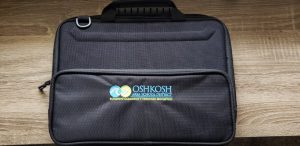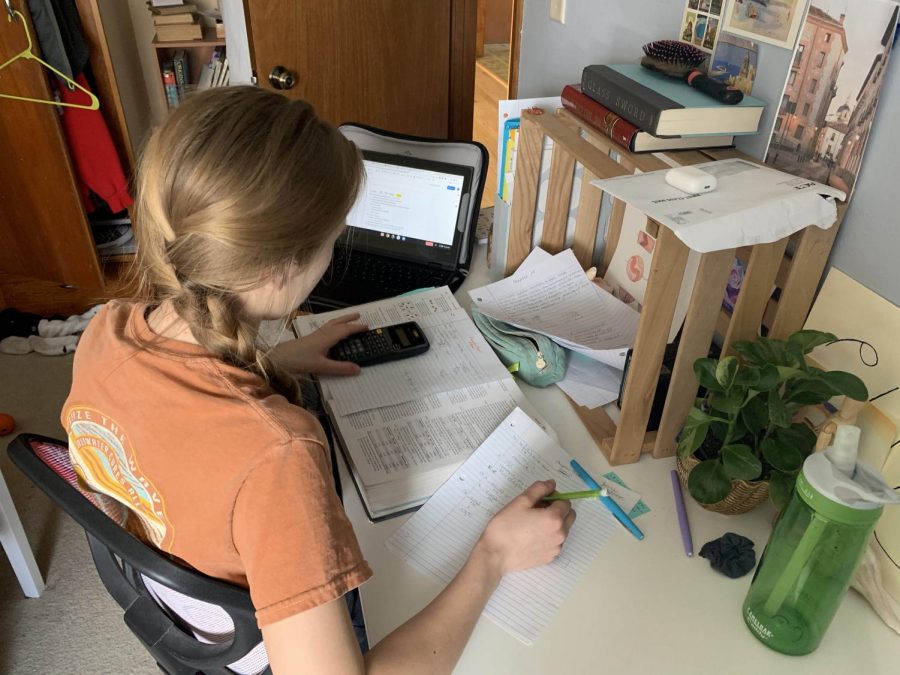OASD works to combat opportunity gaps created with at-home learning
Submitted photo – K-12 students throughout Wisconsin are learning at home after school districts closed to stop the spread of the novel coronavirus.
April 16, 2020
Students and teachers across the Oshkosh Area School District are adapting to at-home learning, but opportunity gaps have caused some students to have a more difficult time adjusting than others.
The district began implementing at-home learning on March 18. Students in third grade or above took their Chromebook laptops home, and students in kindergarten through second grade were given paper assignments to work on, according to the OASD At-Home Learning Plan.
For elementary school students, the focus isn’t on learning new material; it’s ensuring students retain what they’ve already learned with a focus on literacy, math and science, according to OASD Director of Learning Kim Brown.
“It’s a difficult time for families, and that’s why we’re trying to be flexible, and we’re just trying to help maintain where the kids are because we know it’s a lot for families,” she said.
To continue practicing math skills, students can use the Bridges: Math Learning Center website to continue learning, along with the paper assignments they were sent home with, Brown said. For literacy, she says it’s essential that students continue reading and writing at home.

But for some elementary school students, continuing their schooling at home can be a struggle, according to Amy Sippert, a first grade teacher at Merrill Elementary School.
Some families are dealing with “resource scarcity” and do not have books for children to read, or paper to write on beyond what was given out from the district, Sippert said.
In terms of accessing the Bridges website, she said some families with children in kindergarten through second grade don’t have a device.
Beyond resource scarcity, Sippert said some parents are considered essential workers and need to continue going to work to keep food on the table and cannot ensure their child is actively doing schoolwork.
In some families, older siblings are often being forced to take care of their younger siblings during the day, she said.
“Not every child has the same opportunity; it’s not like you have all 20 children in your classroom every day,” Sippert said.
At Merrill Elementary, she said the school has a “huge gap in equity” due to socioeconomic factors.
“I like to think about it as an opportunity gap; resources and experiences are just not there,” she said. “When you’re at-home learning, it’s the same thing, except possibly an even bigger gap.”
The district is trying to close the opportunity gap by mailing new coursework to families and providing Wi-Fi hotspots to those without internet access, according to OASD Technology Integration Coach Amy Monigal.
She said the district’s reading and math coaches have been assembling packets of materials for students to complete at home.
The company that produces math coursework has provided the district with free digital resources for families, which have been printed and sent to them in the mail, Monigal said.
Besides math coursework, she says the district is also mailing students in kindergarten through second grade reading materials because many have already finished reading the books they took home in March.
“The biggest push is to try to figure out how we can get more reading resources into kids’ hands, and that’s where, I think, the equity [gap] comes into play,” Monigal said. “There are so many online companies that are opening up their subscriptions to parents and teachers free of charge. But if a family doesn’t have a device, then there’s no way for them to access it.”
She added that the district has had early discussions about providing families with devices to access reading materials online, but currently there isn’t a plan in place.
For middle and high school students, the district is focused on continued learning through the learning management system Canvas, according to OASD Director of Curriculum and Instruction Julie Conrad.
Conrad said the district is focused on teaching students “essential course content” for each course at every grade level.
Brett Hartman, an English teacher at Oshkosh West High School, said much of his class was already on Canvas during the regular semester, so the transition to at-home learning was relatively smooth.
Each week, Hartman posts a calendar with due dates and assignments on Canvas. He also tries to make daily videos with updates and reminders for students about what they should be working on.
Early on, Hartman tried to make his videos professional and polished, but after getting feedback from students, his videos became more casual to mirror his teaching style.
“I’m going to get the information across that I need to, but I’m going to try to make it as entertaining and as laid back as possible,” he said. “Even though it’s become easier, it’s still nowhere near as impactful as it is to be in person with the kids. That’s something that online learning will never be able to replace.”
Hartman said the share of students completing assignments hasn’t changed too much from the start of the semester.
To assist students during the pandemic, OASD has extended due dates to give students more time to complete assignments. It is also not penalizing students for turning in late work, Hartman said.
Sara Klein, an English teacher at Oshkosh North High School, has seen similar results in her class this semester.
Klein teaches a “dual credit” class where students receive both high school credits and credits at Fox Valley Technical College.
Because students are receiving college credit, Klein says they’re more invested in completing work on time.
“My students are invested, so I don’t have to do a whole lot of parent contact unless they get far behind,” she said. “I don’t have to do as much hand-holding as if you have an elementary student.”
Still, high school students are facing unique challenges as a result of the pandemic. Some of Hartman’s students are essential workers and have had to pick up hours because their families need additional income.
“They have more of a focus on working and obviously staying healthy than they do on school,” Hartman said.
To reduce the burden on students, the district has introduced an opt-in pass/fail grading system for middle and high school students, Conrad said.
At the end of May, students will have the option to finish each course for a letter grade or a pass/fail grade, she noted.
A grade of a C or better will count as a pass, and a grade of a D or F will count as a No Evident grade, Conrad said. She added that pass/fail grades will not affect a student’s GPA or class rank.
Conrad and Brown said the transition to at-home learning is bound to cause education gaps for students.
To combat the gap in education, they said the district is planning to back-fill next year’s classes, meaning content from this year will be reviewed next year to bring students up to speed.
For example, students generally move from algebra to geometry, but next year students in geometry classes would review key concepts from algebra before learning new material.
“We’re already taking a look at how that’s going to look as we move forward and how we’re going to know where to start with the students,” Brown said.
Beyond lenient grading procedures and plans to catch students up, Conrad says OASD has social workers, counselors and psychologists available for students dealing with mental health struggles or difficulties at home.
“You can control your classroom environment, but you can’t control the at-home environment, and that’s the wild card in all of this,” Conrad said.














